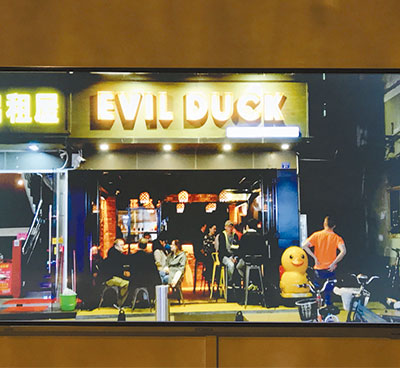
Cao Zhen caozhen0806@126.com ONCE again, the season of art college graduation exhibitions is upon us, providing graduates with a chance to take their first steps to independence outside an institutional environment. Thirty-one graduates majoring in fine arts from domestic academies are now showcasing their creations at the “Fresh Vision 2017” exhibition at the C2 hall in OCT-LOFT. As an annual young artist program that OCAT Shenzhen and OCT Art and Design Gallery have been promoting for 14 years, “Fresh Vision” has been a platform where students express their thoughts about the relation between “me” and the universe. With the theme of “antibody,” this year’s exhibition focuses on individual spirit and attitude in art creation. “From ‘following’ to ‘offending’ and from ‘homage’ to ‘breakthrough,’ what we see from these are the students’ growth path,” according to the exhibition’s curators Xie Anyu, Yu Minling and Meng Xiangyuan. “The students only represent a small part of the whole art circle but they are the most dynamic part,” said Xie. “Apart from institutional art education, today’s students are overburdened with huge amounts of information from outside, so it’s more important for them to maintain the individuality of their work.” At this year’s exhibition, some students examine the self-centeredness of themselves as Millennials. Wu Lingshu from Guangzhou Academy of Fine Arts created a bedroom installation with all the furniture and personal belongings in pink. The bedroom looks warm and cozy but when visitors step closer, they will find that all the objects are pasted thickly with countless tiny sticky tags with Wu’s name hand-written on each of the tags. In the caption, Wu wrote that as a person born in the 1990s, she has a strong sense of self-entitlement. “We Millennials have an acute desire to be in possession of everything, to control everything. We want to be the protagonist of the world. This desire has affected our perception of the objective world and may cause conflicts between ourselves and peripheral people and things.” “Ge Yu Road,” this summer’s funny but inspiring Internet sensation in China, is also displayed here, examining the conflict between an individual and a public space. As part of an art project back in 2013, China Central Academy of Fine Arts postgraduate student Ge Yulu erected a road sign with his name on it on an unnamed road in Beijing’s Chaoyang District. Ge’s name “lu” conveniently ends in the Chinese character for “road.” By 2016, Ge was astonished to find that his mischievous act became reality: His name had been used as the official name for the road on major map apps and traffic tickets. Later, he felt he had the responsibility to take good care of the road and even had plans to install trash bins to improve “his” road. Ge also shot a video of the road, recording what had happened along it over the course of a day. After Ge showed the project at his academy’s graduation exhibition in June, it soon became a spark on the Internet and finally was noticed by local urban planning authorities. Since Ge violated the law, his sign was removed from the road and all mapping apps. A new sign with the road’s original name “Baiziwannanyi Road” was then erected. On China Central Television’s news commentary program “News Weekly,” Ge admitted that he violated public order, saying “Artists don’t have the privilege to break the law.” “My major is experimental art, which focuses on the integration of art and sociology. Contemporary art is a dynamic combination of materials, methods, concepts and subjects. When I created ‘Ge Yu Road,’ I fused my individuality into a public space to evoke the public’s awareness of civic engagement and to help people have some connection with the city they live in. When it was used as an official road name by major map apps, I thought it provided convenience to the public. Finally, the authorities revealed the road’s original name. Whatever the road’s name is now, from an artistic perspective, this project triggered discussion on public space,” said Ge in the TV program. Some graduation works at the exhibition touch upon environmental, migrant or gender issues. Yang Teng’s “Year of Corrosion” is a drain outlet splashing sewage made up of Lego bricks. In the caption, Yang wrote that the work was inspired by the polluted Xinchang River in his hometown in Zhejiang Province. The student’s home was near two chemical plants, which polluted the river. The surging and splashing sewage of colorful Lego bricks creates a powerful and aesthetic effect. One Shenzhen-related work at the exhibition is Li Chaoran’s “Evil Duck,” a 15-minute three-screen video shot in Shuiwei village in Futian District. Set in Evil Duck, a bar favored by local expats, the video centers on four young people, Catherine, Kai, Daniel and Pontus, who meet at the bar and get connected through drinking and chatting. Li, a postgraduate from China Academy of Art, said he tried to explore the uncertainty and strangeness in urban life. Some students adapted freely from past masterpieces such as Qiu Bei’s print series “Growth Report of the Durer Hare” and Cao Bingjie’s video “Vitruvian Women.” Qiu’s work was inspired by Albrecht Durer’s classic watercolor painting “Young Hare” and questions transgenic technology. Cao replaces Leonardo da Vinci’s “Vitruvian Man” with images of women of different ages and races to focus on feminist issues. Dates: Until Oct. 8 Hours: 10 a.m.-5:30 p.m., closed Mondays Venue: C2, North Area, OCT-LOFT, Nanshan District (南山区华侨城创意文化园北区C2展厅) Metro: Line 2, Qiaocheng North Station (侨城北站), Exit B | 
